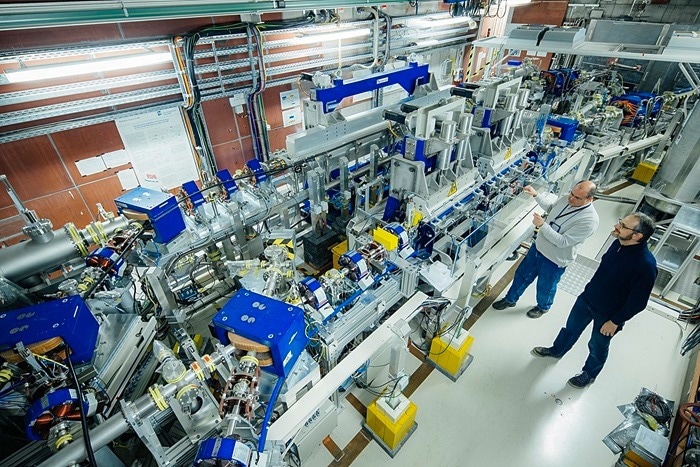Through experiments conducted at the Helmholtz-Zentrum Dresden-Rossendorf (HZDR), an international research team has recently added another aspect to graphene's exciting properties.
 Dr. Stephan Winnerl (right) talks to FELBE physicist Dr. John Michael Klopf about experiments at the HZDR’s FELBE free-electron lasers. Image Credit: HZDR/Oliver Killig
Dr. Stephan Winnerl (right) talks to FELBE physicist Dr. John Michael Klopf about experiments at the HZDR’s FELBE free-electron lasers. Image Credit: HZDR/Oliver Killig
The researchers, under the direction of the University of Duisburg-Essen (UDE), shot micrometer-sized graphene discs with brief terahertz pulses that momentarily transformed them into unexpectedly powerful magnets. The results, which were published in Nature Communications, could aid the development of magnetic switches and storage devices.
Graphene comprises a single, extremely thin layer of carbon atoms. One of its most notable properties is its exceptional electrical conductivity, which is precisely what researchers from Germany, Poland, India, and the United States of America exploited in this investigation.
The international team used well-established semiconductor methods to apply thousands of tiny, micrometer-sized graphene discs onto a small chip. After that, the device was subjected to brief terahertz pulses, a specific kind of radiation that falls between the microwave and infrared spectrums.
The working group headed by the UDE chose a specific light source for the experiment, the FELBE free-electron laser at the HZDR, which produces incredibly powerful terahertz pulses, to get the finest possible circumstances.
The tiny graphene disks briefly turned into electromagnets.
Dr. Stephan Winnerl, Physicist, Helmholtz-Zentrum Dresden-Rossendorf
He added, “We were able to generate magnetic fields in the range of 0.5 Tesla, which is roughly ten thousand times the Earth's magnetic field.”
These were extremely short magnetic pulses, lasting barely a tenth of a billionth of a second, or 10 picoseconds.
Radiation Pulses Stir Electrons
The requirement for success was that the terahertz flashes had to be polarized precisely as described by the researchers. With specialized optics, the radiation’s oscillation direction was altered so that it appeared to be traveling across space helically.
The critical outcome happened when these circularly polarized flashes struck the micrometer-sized graphene discs. Here, the free electrons in the discs were stimulated by the radiation and started to circle. Additionally, the graphene disks changed into small electromagnets since a circulating current always produces a magnetic field under fundamental physics.
The idea is actually quite simple. In hindsight, we are surprised nobody had done it before.
Martin Mittendorff, Professor, University of Duisburg-Essen
The process’s efficiency is just as astounding. The experiment at the HZDR was a million times more efficient than examinations irradiating gold nanoparticles with light, which is an amazing boost.
The novel phenomena can initially be applied to scientific investigations that examine certain material characteristics in more detail by exposing material samples to brief yet intense magnetic pulses.
Winnerl added, “With our method, the magnetic field does not reverse polarity, as is the case with many other methods. It, therefore, remains unipolar.”
To put it another way, its north pole and south pole continue to exist for the ten picoseconds that the magnetic pulse from the graphene disks lasts.
The Dream of Magnetic Electronics
Eventually, those small magnets could be generated by ultra-short radiation flashes, allowing the graphene discs to perform accurate and quick magnetic switching operations. This has potential applications in magnetic storage technology and in the field of spintronics, which is a subfield of magnetic electronics.
Here, weak magnetic fields in the form of electron spins are transferred like small batons in place of electrical charges flowing through a processor. It is envisaged that this would once again greatly accelerate the switching operations. It is possible that in the future, graphene disks will be utilized as switchable electromagnets to operate spintronic devices.
To do this, specialists would need to create extremely tiny, highly miniaturized terahertz sources, so there is still a long way to go.
Winnerl concluded, “You cannot use a full-blown free-electron laser for this, like the one we used in our experiment. Nevertheless, radiation sources fitting on a laboratory table should be sufficient for future scientific experiments.”
There are already several research facilities with significantly more compact terahertz generators.
Journal Reference:
Han, J. W, et. al. (2023) Strong transient magnetic fields induced by THz-driven plasmons in graphene disks. Nature Communications. doi:10.1038/s41467-023-43412-x.